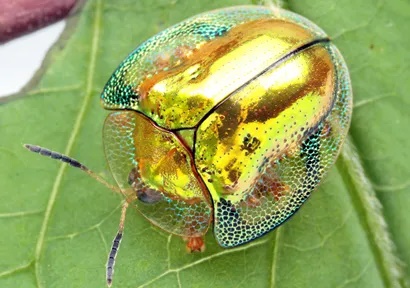This little bug could easily be mistaken for a sequin that had fallen off some snazzy dress. It has the size, shape, and shininess of a gold sequin, but it is a Golden Tortoise Beetle (Charidotella sexpunctata). This particular species of beetle is native to the Americas and is most common in states on the East Coast. Lately, however, it has been making headway in the Midwest and down into Texas. Golden Tortoise Beetles are still not super-common and do not congregate in large numbers like many similar beetles, so finding one still has the surprise element for most people.
Golden Tortoise Beetles (aka Goldbugs) are not always bright metallic gold in color. They can also be a reddish-brown or a mottled mix of red and gold. Goldbugs have a special ability to change their colors and these color changes are directly related to the mood of the insect. While the metallic color indicates an at-peace bug, when they feel threatened or annoyed their color becomes red. They manage this change by drying up the fluid in their clear exoskeleton (here is an article that explains this with a Panamanian version of the Goldbug). Scientists believe the color change may make the insect appear poisonous to predators, but that reasoning does not explain another situation where they change colors – during mating. When mating, both parties will go from gold to red. Mating appears to be an intense event for Goldbugs; according to this article there have been studies that show that copulation can last nearly ten hours! Apart from some Australian crab spiders that change colors when hunting, Goldbugs seem to be unique in the insect world with this ability to change color at will.




